Pedestrian accidents can result in serious injuries and even fatalities, leaving victims and their families devastated; as Shamsi Law reports, in California alone, the annual count of pedestrian fatalities in traffic accidents fluctuated between 997 and 1,169 over the span of a recent four-year period.

photo credit: Quintin Gellar / Pexels
In the aftermath of such accidents, determining responsibility and knowing what steps to take can be crucial for ensuring victims receive the support and compensation they need to recover. Here’s a guide to understanding pedestrian accidents, identifying responsible parties, and knowing what actions victims should take.
Understanding Pedestrian Accidents
Pedestrian accidents occur when a pedestrian is struck by a vehicle while walking or crossing the road. These accidents often result from negligence, recklessness, or disregard for traffic laws on the part of drivers or pedestrians. Common causes of pedestrian accidents include distracted driving, speeding, failure to yield, impaired driving, and poor visibility conditions.
Pedestrian accidents can lead to severe injuries such as broken bones, head trauma, spinal cord injuries, and internal organ damage. In the worst-case scenario, pedestrian accidents can be fatal, resulting in the loss of life and devastating consequences for victims and their families.
Who’s Responsible for Pedestrian Accidents?
Determining liability in pedestrian accidents requires a careful examination of the circumstances surrounding the incident. In many cases, the driver of the vehicle involved in the accident may be held responsible for the collision, particularly if they were negligent or violated traffic laws. Factors that may contribute to driver liability include speeding, distracted driving (such as texting or using a mobile phone), driving under the influence of alcohol or drugs, and failing to yield to pedestrians at crosswalks or intersections.
However, pedestrians themselves may also share responsibility for accidents in certain situations. Pedestrians have a duty to exercise reasonable care for their own safety and adhere to traffic laws and signals. Failure to do so, such as jaywalking, crossing against the signal, or walking while intoxicated, may contribute to their own injuries and impact liability in a pedestrian accident case.
Additionally, other parties such as local governments or property owners may bear responsibility for pedestrian accidents if hazardous road conditions, inadequate signage, or poorly maintained infrastructure contributed to the accident.
What Should Pedestrian Accident Victims Do?
If you or someone you know has been involved in a pedestrian accident, taking the following steps can help protect your rights and ensure you receive the necessary support and compensation:
- Seek Medical Attention: The well-being of accident victims is the top priority. Seek immediate medical attention for any injuries sustained in the accident, even if they appear minor. Prompt medical care can prevent injuries from worsening and document the extent of your injuries for insurance and legal purposes.
- Report the Accident: Contact law enforcement to report the accident and file an official police report. The police report will document the details of the accident, including the parties involved, witness statements, and any contributing factors. This report will be valuable evidence in your case.
- Gather Evidence: If possible, gather evidence at the scene of the accident, including photos or videos of the accident scene, vehicle damage, road conditions, and any visible injuries. Collect contact information from witnesses who may have observed the accident and can provide statements regarding what they saw.
- Exchange Information: Exchange contact and insurance information with the driver(s) involved in the accident. Obtain the driver’s name, address, phone number, license plate number, and insurance details. Similarly, if you were involved in a hit-and-run accident, try to gather as much information about the fleeing vehicle as possible.
- Consult with a Personal Injury Lawyer: You shouldn’t deal with the accident and injury all by yourself! Contact a skilled personal injury lawyer who specializes in pedestrian accident cases. A lawyer can review the details of your case, assess liability, and advise you on your legal options for pursuing compensation. They will handle all communication with insurance companies and legal proceedings on your behalf, allowing you to focus on your recovery.
- Document Your Injuries and Expenses: Keep detailed records of all medical treatments received for your injuries, including hospital visits, surgeries, medications, and rehabilitation therapy. Retain copies of medical bills, receipts, and other related expenses. These documents will help quantify your damages and support your compensation claim.
- Know Your Rights: Familiarize yourself with your rights as a pedestrian accident victim. You may be entitled to compensation for medical expenses, lost wages, pain and suffering, and other damages resulting from the accident. An experienced personal injury lawyer can help you understand your rights and pursue the maximum compensation available under the law.
Conclusion
Pedestrian accidents can have devastating consequences for victims and their families, often resulting in serious injuries, financial hardships, and emotional trauma. Identifying responsible parties and taking appropriate actions following an accident is crucial for protecting victims’ rights and pursuing the compensation they deserve.
By understanding the causes of pedestrian accidents, knowing who may be held liable for injuries, and seeking legal guidance from a qualified personal injury lawyer, pedestrian accident victims can navigate the complexities of the legal process with confidence. With the support of legal professionals, victims can pursue justice, hold negligent parties accountable, and secure the compensation needed to recover and move forward with their lives.


